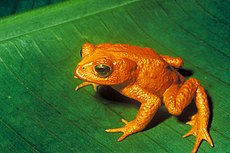Least-concern species
| Conservation status | |
|---|---|
 | |
| Extinct | |
| Threatened | |
| Lower Risk | |
Other categories | |
| (list) | |
Related topics | |
 Comparison of Red List classes above and NatureServe status below  | |
Least Concern (LC) is an IUCN category assigned to extant taxon or lower taxa which have been evaluated but do not qualify for any other category. As such they do not qualify as threatened, Near Threatened, or (prior to 2001) Conservation Dependent. Many common species such as the Rock Pigeon, Honeybee, Asian Tiger Mosquito, Common Juniper, Snail Kite, Sacred Kingfisher and House Mouse, as well as humans, are assigned the Least Concern category.
Species cannot be assigned the Least Concern category unless they have had their population status evaluated. That is, adequate information is needed to make a direct, or indirect, assessment of its risk of extinction based on its distribution and/or population status.
Since 2001 the category has had the abbreviation "LC", following the IUCN 2001 Categories & Criteria (version 3.1).[1] However, around 20% of Least Concern taxa (3261 of 15636) in the IUCN database use the code "LR/lc", which indicates they have not been re-evaluated since 2000. Prior to 2001 "least concern" was a subcategory of the "Lower Risk" category and assigned the code "LR/lc" or (lc).
While "Least Concern" is not considered a red listed category by the IUCN, the 2006 Red List still assigns the category to 15636 taxa. The number of animal species listed in this category totals 14033 (which includes several undescribed species such as a frog from the genus Philautus[2]). There are also 101 animal subspecies listed and 1500 plant taxa (1410 species, 55 subspecies, and 35 varieties). There are also two animal subpopulations listed: the Australasian and Southern African subpopulations of Spiny Dogfish. No fungi or protista have the classification, though only four species in those kingdoms have been evaluated by the IUCN. Humans qualify for this category, and in 2008 were formally assessed[3] as such by the IUCN.
Similar classifications
- The COSEWIC designates Wildlife Species as Not At Risk (NAR) when they have been evaluated to be not at risk of extinction given the current circumstances.
- The NatureServe conservation status uses the ranking of Secure (G5) for "demonstrably widespread, abundant, and secure" species which have a stable population
- The WWF uses "relatively stable/relatively intact" (RS) as the least concern status for ecoregions.
Many category or ranking systems simply do not list Least Concern species. For example Australia's EPBC Act does not have a category for "not at risk" species, although such species may be found amongst the lists of "unsuccessful nominations" or "removed" (delisted) fauna and flora. There are, however, other reasons species may be found on these lists, such as taxonomic changes. The US Endangered Species Act likewise does not list species which are not at risk.
See also
References
- ^ "2001 Categories & Criteria (version 3.1)". The IUCN Red List of Threathened Species. Archived from the original on 2006-11-14. Retrieved 2006-12-19.
- ^ "Philautus sp. nov. 'Kalpatta'". The IUCN Red List of Threathened Species. Retrieved 2006-12-19.
- ^ "IUCN Red List - Homo sapiens". The IUCN Red List of Threathened Species. Retrieved 2008-10-12.
This article needs additional citations for verification. (July 2009) |
External links
- List of Least Concern species as identified by the IUCN Red List of Threatened Species
